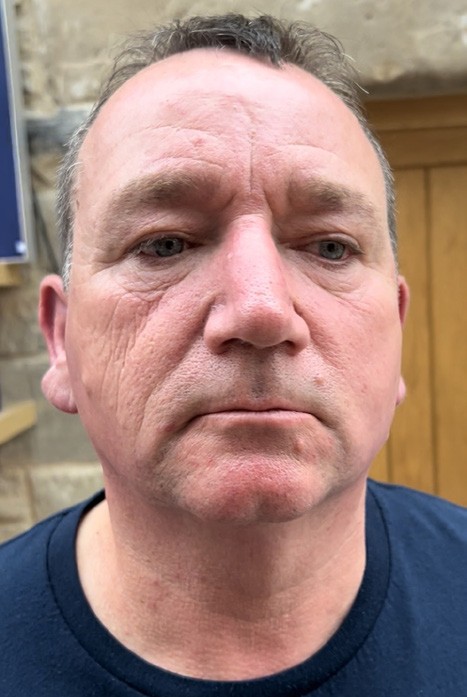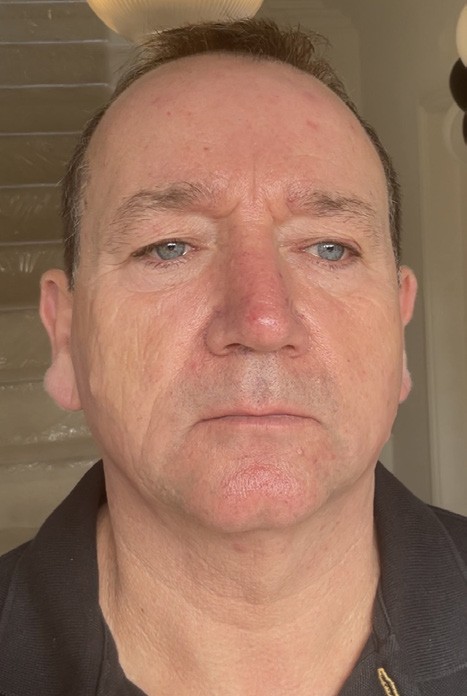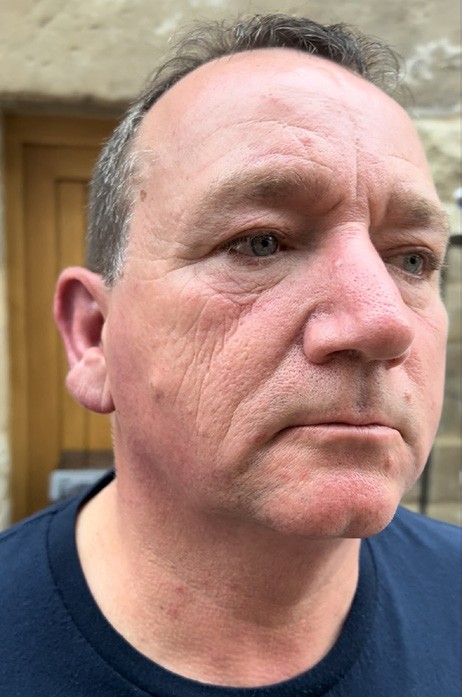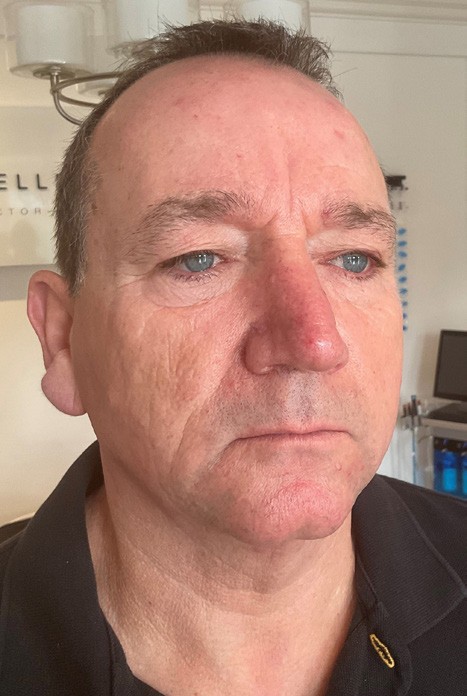TREATING EXTREME SUN DAMAGE
Dr Hannah Higgins, medical director of The Wellness Space discusses her treatment of a 54-year-old lorry driver with extreme unilateral sun damage
The patient originally came to Dr Hannah Higgins in May 2022 to wait while his wife-to-be received an aesthetic treatment. He jokingly asked if anything could be done about the right side ofhis face, which was ‘different’. At this point, Dr Higgins didn’t realise itwas the result ofsun damage. “The difference between the two sides ofhis face was so marked, that it wasn’t the first thing that came to my mind,” she says.”More often than not, patients have asymmetrical faces which can cause asymmetrical lines, orthese can be caused by always sleeping on one side.”
However, when they met for a consultation, Dr Higgins asked a series of detailed medical questions to understand more about what could have caused the extreme difference between the right and left side of his face, including potential neurological conditions, or previous injuries. “After ruling out any other causes, I asked him what he did for a living, and discover he had worked as a truck driver, six days a week, for 30 years. While his driving never took him out of the UK, he had never used sunscreen of any kind, even during the summer. The damage was on the right side the side next to the window of the truck.”
SKIN CONDITION
On examination the patient’s entire face showed signs of UV damage; there was diffuse and severe redness, pigmentation, enlarged pores, and an overproduction of oil.
On the right-hand side specifically, Dr Higgins observed deep lines and wrinkles in the anterior, medial area of his face and laterally towards his zygomatic area. Across these areas, there was significant volume loss in the order of 0.6cm to 0.7cm depth, compared with the left side of his face, which had caused the skin in that area to concertina, causing the deepening of lines and wrinkles. The skin was also crêpey as a result of collagen loss. The result was that the right-hand side of this patient’s face was that of someone in their late 60s to early 70s (when he is 54).
TREATMENT AND TREATMENT CONSIDERATIONS
“There are a wide variety of potential treatments to tackle this kind of skin damage,” says Dr Higgins. “If this had been a patient with greater experience and understanding of skincare and aesthetic treatments, I might have looked to implement a longer and more detailed treatment plan. However, I knew that, to build trust, for this patient, the results would need to be as quick as possible, and then, after he started to realise the value of our interventions, he may be open to treatments that take longer with more downtime in the future.
“Other treatment considerations included, that it was extremely important that any treatment was completely undetectable and that downtime was minimal. Therefore, my choice of product made sure that afterwards, his facial expressions would be unaffected, and that the product would degrade equally, so as not to produce any unusual visual deformities.”
Before injectables, Dr Higgins started the patient on a three-month, normalising course of medical-grade ZO skincare to repair his skin barrier, redness and inflammation, and control oil production caused by UV exposure. “In my opinion, his condition was worsened due to increased exposure to toxins found whilst driving, such as vehicle exhausts,” she adds.
This included a morning and evening protocol of gentle cleanser, oil control pads, a daily power defence serum (to defend skin against free radicals damage and accelerate barrier restoration), Rozatrol redness reduction, a mild exfoliator, plus a medicalgrade, broad spectrum SPF 50 every day. This treatment alone made a significant difference. “Studies show how SPF alone can improve the skin ifused every day,” says Dr Higgins. “Many people do not understand that they are still vulnerable to sun damage, even when sitting behind glass. Research shows that smooth, ordinary glass transmits 74.3% ofUVA.1

Before (front)

After (front)

Before (side)

After (side)
“In one study which followed 900 people for four years, some participants were told to use sunscreen every day and re-apply after being outside for two hours, while the other group was not given any guidance (it was considered too unethical to ask them not to use sunscreen). Those who used sunscreen daily were 24% less likely to show increased signs of ageing. The study also found that even participants who started daily sunscreen applications in their 40s and 50s showed reduced signs of ageing.”
Following the three-month regime, the patient returned to the clinic for his injectables treatment. The first treatment comprised 0.7mls MaiLi Extreme which was applied deeply to the mid-face (deep and more superficial fat pads) using a cannula. Because it was a unilateral treatment, only a relatively small volume of filler was used.
“I understood this initial treatment was not going to repair the lines in the patient’s dermis immediately, but I aimed to create some structure underneath the anterior medial mid-face, to give the skin structure as it began to repair and become healthier with the help of SPF and barrier repair,” says Dr Higgins. “I expected over time, with better skin support for the overlying skin, that the lines would start to diminish.”
MaiLi Extreme settled well and the patient’s lines decreased by approximately 10-15%. One month later, Dr Higgins used 1ml MaiLi Volume for the next stage of treatment, via a needle to inject the dermis using Dr Tom van Eijk’s ‘fern’ technique. “This works in several ways, the controlled trauma caused by injecting the needle in the fern pattern works similarly to microneedling to cause an increased skin remodelling,” she says. “The filler is injected to create a ‘scaffolding effect within the skin’ and as such, less filler is needed. Because the filler is injected dermally rather than subdermally, it allows for ‘skin strengthening’ rather than volume correction, which can give a very natural result. The skin can even utilise the hyaluronic acid, and so, with all of this support, enhanced remodelling, and HA for fuel, over the years I have seen great results using this technique.”
TREATMENT RESULTS
The treatment has successfully addressed the asymmetry of the patient’s face. The redness is hugely reduced, and he generally now looks healthier without anyone being able to tell he has had anything ‘done’. The lines and wrinkles are significantly decreased because of both the MaiLi Extreme and MaiLi Volume, and the ZO skincare regime.
He feels more confident and is now looking forward to marrying his partner this year. His friends and family have commented that he now looks well, and some male friends are so impressed with the results they have also sought treatment.
The patient nowuses SPF 50 fastidiously every day and is receiving regular Dermalux triwave MD LED treatment at Dr Higgins’ clinic. “I expect his treatment to last a yearto 18 months, even then I wouldn’t expect to top up the fillerwith the same amount as the initial treatment,” she adds.
“I find both MaiLi fillers very effective. MaiLi Extreme has OxiFree technology which allows the gel to behave like smart springs (i.e. maintaining facial expressions). In my practice, I use it in areas where sustained volume is needed to mimic denser tissue. MaiLi Volume is great at creating malleable fullness and refined results. I find it flows well through a fine gauge needle, enabling very accurate work, but whilst still achieving long-lasting results.”
CONCLUSION
This patient is a prime example of the extensive damage UVA and UVB can cause without the use of an effective sunscreen. The fact damage of this significance and to this depth was caused by the sun in the UK, often through glass, shocked even Dr Higgins.
“I tell my patients that if they use SPF every day their skin is going to look better, less prone to pigmentation, fine lines and wrinkles from an aesthetic perspective,” she concludes. “But, most importantly, they are much less likely to get skin cancer. I’ve already noted various studies proving the detrimental effects of the sun and how ageing it can be.
“However, the depth of the damage is something less talked about. Worryingly, UVA is proven to reach deep into the hypodermis, down to the bone, and as such all those tissues between these layers are being damaged, (not just the visible skin), as seen in this patient. This just gives even more reason (as if one were needed), to be educating patients all year round, about the importance of sun protection.”
REFERENCES
1 Duart et al (2009). The role of glass as a barrier against the transmission of ultraviolet radiation: An experimental study, Photodermatology Photoimmunology and Photomedicine 25(4):181-4
1 Hughes et al (2013) Sunscreen and Prevention of Aging, a randomised trial. Annals of Internal Medicine https://www. acpjournals.org/doi/10.7326/0003-4819-158-11-201306040-00002
1 Lorenzo et al (2006) Safety of UV radiation for autofluorescence diagnosis of skin cancer. Revista Mexicana de Fisica